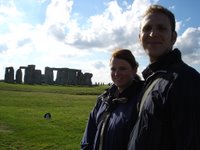Climbin' up on Salisbury Hill
I could see the city light
- Peter Gabriel
This weekend Anna, Jan and I went on a day trip to
 Due to tensions between the clergy and the military stationed nearby (who were taking pot shots at the stained glass windows), the cathedral was resited at “New Sarum” (current day
Due to tensions between the clergy and the military stationed nearby (who were taking pot shots at the stained glass windows), the cathedral was resited at “New Sarum” (current day
The rest of Old Sarum was eventually destroyed, and the remains are visible just outside the city in the form of a large grassy hill, rather like a pa.
Salisbury Cathedral
 The new cathedral, however, is a thing of wonder. It was built entirely in 38 years, which means that it is contiguous in style - in contrast to the motley appearance of most English cathedrals, built over several intervening stylistic periods. The spire is 123 metres, and is the tallest in the
The new cathedral, however, is a thing of wonder. It was built entirely in 38 years, which means that it is contiguous in style - in contrast to the motley appearance of most English cathedrals, built over several intervening stylistic periods. The spire is 123 metres, and is the tallest in the
Due to the marshy landscape, the cathedral is built on a bed of gravel chips. During drought, when the water tables recede, there is fear that the gravel will dry out and crumble. There is a plumbline in the floor where the transept intersects the nave, so that they can test the water levels with a long pole.
 Displayed in the nave are a medieval clock -
Displayed in the nave are a medieval clock -
Finally, the cathedral chapter house (through the magnificent adjoining cloister) displays the best-preserved of the four surviving original copies of the Magna Carta, the “Great Charter of Freedoms” from 1215 by which “the will of the king could be bound by law”.
After a tense wait for lunch at the slowest pub in
Our coach took a nice ride through the countryside, where we were able to see lots of thatched houses, Sting’s palatial estate (where Madonna and Guy Ritchie met, and later honeymooned), and a view of Old Sarum.
 We arrived at
We arrived at
 The work and intelligence behind the site is very impressive. 43 of the smaller “blue” stones were brought from a quarry in
The work and intelligence behind the site is very impressive. 43 of the smaller “blue” stones were brought from a quarry in
 Obviously it was disappointing not to be able to go up to the stones, but given that people had been chipping away souvenirs and sitting down to picnics on the Heelstone, I think we all accept that the site must be preserved for the future. Now if only they would get rid of the birds nesting in the sarsen stones!
Obviously it was disappointing not to be able to go up to the stones, but given that people had been chipping away souvenirs and sitting down to picnics on the Heelstone, I think we all accept that the site must be preserved for the future. Now if only they would get rid of the birds nesting in the sarsen stones!
Interestingly the surrounding landscape is littered with Neolithic long barrows (i.e. trapezoidal earth mounds traditionally interpreted as collective tombs).
No comments:
Post a Comment